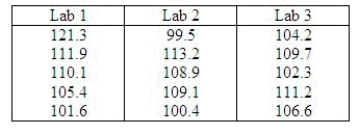Short Answer
Physicians depend on laboratory test results when managing medical problems such as diabetes or epilepsy. In a uniformity test for glucose tolerance, three different laboratories were each sent nt = 5 identical blood samples from a person who had drunk 50 milligrams (mg) of glucose dissolved in water. The laboratory results (in mg/dl) are listed here:  Do the data indicate a difference in the average readings for the three laboratories? Use Tukey's method for paired comparisons to rank the three treatment means. Use
Do the data indicate a difference in the average readings for the three laboratories? Use Tukey's method for paired comparisons to rank the three treatment means. Use  = 0.05.
= 0.05.
What is the F-statistic?
______________
What is the p-value?
______________
Can you reject the null hypothesis?
______________
There ______________ sufficient evidence to indicate a difference in the treatment means.
Correct Answer:

Verified
0.6106; 0.5591; Fail...View Answer
Unlock this answer now
Get Access to more Verified Answers free of charge
Correct Answer:
Verified
View Answer
Unlock this answer now
Get Access to more Verified Answers free of charge
Q5: The test statistic of the completely randomized
Q6: Tukey's method for paired comparisons makes the
Q7: One-way ANOVA is performed on three independent
Q8: In an ANOVA test, the test statistic
Q9: In a two-way ANOVA, there are 4
Q11: The number of cells in a two-way
Q12: Why would you use the Tukey multiple
Q13: In a two-way factor ANOVA with replications,
Q14: In a two-way factor ANOVA, the sum
Q15: Which of the following is not true